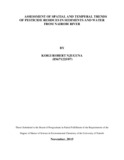| dc.description.abstract | The Nairobi River water is laden with pollutants which emanate from industrial and municipal effluents discharged directly into the river. In the catchment area, riparian agricultural activities and large scale farms contribute to chemical load in the river. The water pollution brings both environmental and health risks to the direct users of the river especially the urban dwellers that use it for irrigation, domestic use, watering animals and in worst case scenario for drinking.
This study was conducted to establish temporal and spatial distribution of the 16 OC and 14 OP pesticides in water and sediment samples from selected sites along the Nairobi River. In addition physicochemical parameters (TSS, TOC, EC, TDS and pH) were determined and correlated with pesticide concentrations. A total of 144 samples comprising of 72 sediment and 72 water samples were collected for six times over a period of six months. The extraction was done using Soxhlet extraction and Liquid-Liquid partitioning techniques and cleaned up using deactivated florisil. The extracts were analysed with Agilent 6890 Gas chromatograph coupled with a 5890 Mass spectrometer system. The statistical data was analysed using Microsoft Excel and Statistical Package for Social Sciences (SPSS). The seasonal pesticide concentrations in sediments ranged between 0.88 to 1385μg/kg and 0.68 to 1984.03 μg/kg for OC and OP pesticides, respectively. p,p’ DDT and a-HCH were dominant and constituted 25% and 11% of the OC pesticides, respectively. The highest average concentrations for p,p’ DDT and a-HCH were recorded at Naivasha Bridge and Muthangari Bridge respectively. Malathion and Chlorpyrifos had the highest average concentrations amongst the OP pesticides at 38% and 27% respectively both recorded at Muthangari Bridge. Muthangari Bridge recorded the highest concentrations of ΣOCP and ΣOPP at 5025.47 μg/kg and 3611.97 μg/kg respectively. ΣOCP were dominant compared to ΣOPP and constituted 58% of total pesticides detected. In water
vi
samples OC pesticides concentrations ranged between 0.02 to 31.79 μg/L, p,p’-DDT and Endrin were dominant and constituted 8% of total OC pesticides, Outering Bridge recorded the highest concentrations of the two pesticides The OP pesticides concentrations ranged between 0.01 to 44.99 μg/L. Ethoprophos recorded the highest average concentration of 19.21 μg/L at Outering Bridge and constituted 58% of total OP pesticides. Outering Bridge recorded the highest ΣOCP and ΣOPP concentrations at 114.19 μg/L and 116.82 μg/L respectively. Positive Pearson correlation coefficients were observed between pesticides, TDS and TSS. A comparison of Σ16 OCP, TSS and TDS in water gave values of 0.485 and 0.424 for TDS and TSS respectively. Similar comparison with ΣOPP gave p values of 0.145 and 0.818 for TDS and TSS respectively. Inter matrix Pearson correlations between Σ16 OCPS and Σ14 OPPS were stronger for sediments which had a p value of 0.905 compared to water, p=0.747.
Fifty six percent of the Nairobi river water samples exceeded the pesticide limit (OC and OP pesticides) of 0.5μg/l in drinking water as set by EC directive 98/83/EC. Comparatively in water the ΣOPPS exceeded ΣOCPS by 1.1 times, signifying higher solubility’s of OP pesticides in river water. This implied that use of Nairobi river water for irrigation and drinking purposes could pose health risks from OP pesticide poisoning to communities that depend on it. The data from this study may form a basis for policy formulation by regulatory authorities. | en_US |

